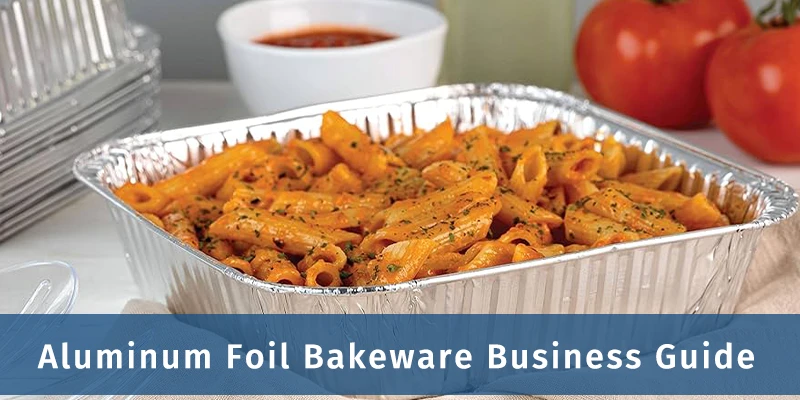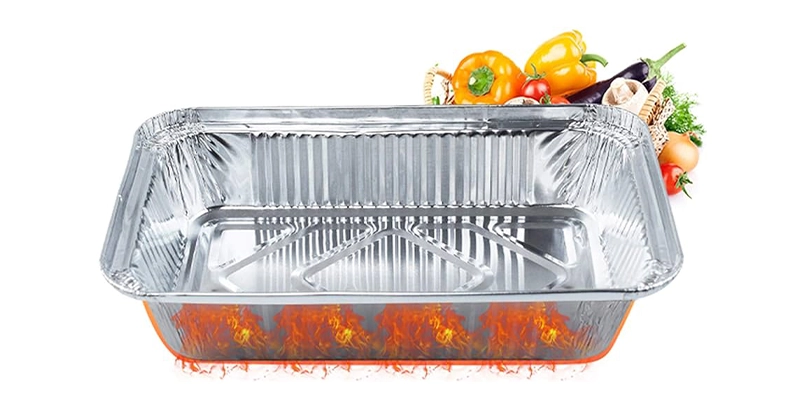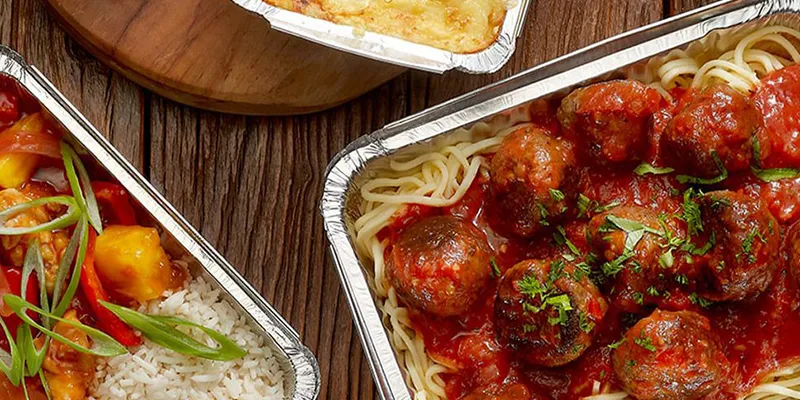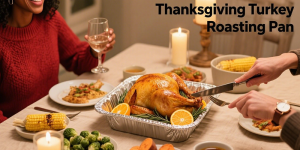For catering equipment dealers, baking supplies wholesalers or people running food businesses, aluminum foil baking pans provide a convenient and affordable solution. This guide will walk you through everything you need to know about the aluminum foil bakeware industry, including market trends product types customer needs and strategies to succeed and help you find a customizable wholesale production supplier. The purpose is to help you start a new business and succeed.

Why Aluminum Foil Bakeware Is a Growing Market?
The demand for aluminum foil bakeware is driven by its convenience affordability and versatility. Consumers increasingly prefer disposable baking pans for events holidays and everyday cooking to save time on cleanup. Restaurants bakeries and catering services also rely on these products for bulk cooking and easy disposal.
Key factors boosting this market include:
- Eco-friendly trends: Many aluminum bakeware products are recyclable, appealing to environmentally conscious buyers.
- Cost-effectiveness: Disposable bakeware eliminates the need for expensive, durable pans.
- Variety: Products like aluminum baking pans with lids foil loaf pans and disposable cake pans cater to diverse cooking needs.
What is The Temperature Range of Aluminum Foil Bakeware?
Most standard aluminum foil bakeware can safely withstand temperatures of -40°F to 450°F (-40°C to 232°C). Some heavy-duty disposable aluminum baking pans may tolerate up to 500°F (260°C), but always check the manufacturer’s instructions.

Is Aluminum Foil Bakeware Oven-Safe?
Aluminum conducts heat efficiently, making it excellent for baking and roasting.
The metal maintains its structure at high temperatures without warping (if high-quality).
Most brands explicitly label their products as “oven-safe” if they can handle standard baking temperatures (up to 450°F).
Can It Be Used In The Microwave?
- Potential Fire Hazard—Aluminum reflects microwaves, which can cause dangerous sparks (“arcing”) and, in extreme cases, even a fire.
- Uneven Heating – Since metal blocks microwaves, food won’t cook properly.
- Manufacturers Warn Against It – Almost all disposable aluminum bakeware packaging states “Not Microwave Safe.”
Food-grade vs Regular Foil Bakeware
Food-Grade and Regular aluminum foil bakeware may look similar, but they are made of different materials and have different safety features.
| Contrast | Food-Grade | Passed FDA (USA), LFGB (Europe), GB 4806 (China), and other food safety certifications |
| Raw material purity | High purity aluminum (aluminum content ≥ 99%), less impurities | May contain recycled aluminum or additives |
| Safety certification | Passed FDA (USA), LFGB (Europe), GB 4806 (China) and other food safety certifications | No strict food contact certification |
| Corrosion resistance | No chemical reaction, not easy to react with acid/alkaline food | May oxidize or react with certain foods |
| Heat resistance | Typically high temperature resistant (450°F+/230°C+) | May deform or release hazardous substances |
| Is it suitable for long-term storage? | Safe for food contact | Not suitable for long-term storage of acidic/salty foods |
| Typical usages | Baking, cooking, food packaging | Industrial use, non-food packaging |
Why Are Food-grade Aluminum Foil Baking Pans Safer?
Strict production standards
Food-Grade Aluminum must comply with food safety regulations, such as:
- FDA: Ensure that no harmful substances are released.
- EC 1935/2004: Suitable for materials in direct contact with food.
- GB 4806: Meets national food contact material standards.
- Ordinary aluminum foil may contain: recycled metals, lead, cadmium and other harmful impurities, and is not suitable for direct contact with food.
Prevent metal migration
Food-grade aluminum foil is specially treated to prevent excessive aluminum ions from penetrating into food, while ordinary aluminum foil may release metal ions when in contact with acidic (such as tomatoes, lemons) or high-salt foods.
More resistant to high temperatures
Food-grade aluminum foil is usually thicker (10-30µm+), not easily deformed by heat, and is suitable for high-temperature cooking methods such as ovens and air fryers, while ordinary aluminum foil may oxidize or melt faster due to impure ingredients.
How To Identify Food Grade Certification?
When buying aluminum foil bakeware, please check the following key points:
- FDA certification (US market)
- LFGB certification (European market)
- GB 4806-2016 (Chinese market)
- Recyclable logo (such as ALU symbol)
Product description
- Marked “Food-Grade”, “Safe for Cooking”.
- Clearly marked “BPA-Free”, “Heavy-Duty” (more durable).
What If I Want To Buy Foil Bakeware In Bulk?
If you’re a buyer looking to import aluminum foil bakeware in bulk, here’s a complete step-by-step guide.
Step 1: Define Your Requirements
BefBefore contacting suppliers, please clarify your needs: Are you using it for baking or cooking? Selling to take-out restaurants? Do you need disposable or reusable? Common foil baking pans are 9×13 inches, 8-inch round and 1/2 half-size baking pans. Some customers have requirements for container thickness, standard: 10 microns-30 microns; heavy duty: more than 30 microns. Baking pans used in the food industry require food-grade safety certification (such as FDA).
Step2: Find Reliable Suppliers
Source from China (Best for Large Orders)
| Platform | Best For | Notes |
| Alibaba (1688) | Factory-direct pricing | Request samples before bulk orders. |
| Made-in-China | Verified manufacturers | Check FDA/LFGB certs. |
| Global Sources | Pre-screened suppliers | Safe for new buyers. |
Local/Regional Suppliers (Faster Shipping)
- USA: WebstaurantStore, ULINE (pre-stocked, higher cost).
- Europe: Metro Chef, Nisbets (foodservice wholesalers).
- India/Middle East: TradeIndia, Justdial (lower costs, longer lead times).
Step 3: Verify Supplier Reliability
Always check:
- Business License (Ask for ISO 9001, FDA/CE certificates).
- Factory Audits (Request videos/production photos).
- Customer Reviews (Search supplier name + “reviews”).
- Sample Testing (Order 10–50 pcs first to check quality).

Payment Security:
- Use Alibaba Trade Assurance (escrow protection).
- Avoid 100% upfront (30% deposit + 70% before shipment).
Step 4: Negotiate Pricing & MOQ
Cost-Saving Tips: ask for tiered pricing.
- 1,000 pcs: $0.15/pc
- 10,000 pcs: $0.10/pc
- 100,000 pcs: $0.07/pc
Request OEM/OEM-free options (cheaper without branding).
Consolidate shipping (reduce costs via LCL/FCL freight).
Sample Negotiation: “We need 50,000 pcs of 9×13 inch food-grade aluminum pans. Can you offer your best FOB price? Do you provide FDA certificates?”
Step 5: Shipping & Customs Tips
Logistics Choices:
| Method | Best For | Lead Time |
| Air | Urgent orders (~5–10 days) | Expensive (8–8–8–15/kg). |
| Sea (LCL) | Small batches (~30–45 days) | 600–600–600–1,500/cbm. |
| Sea (FCL) | Large orders (~30–50 days) | 2,000–2,000–2,000–5,000/20ft container. |
Import Duties & Documents:
- USA: HTS Code 7607.20.50 (3–8% duty).
- EU: No duty on aluminum foil bakeware.
- Required docs: Commercial invoice, packing list, FDA/LFGB certs.
Step 6: Quality Control Before Shipment
Key Checks for Aluminum Foil Bakeware:
- Material Thickness (Use a micrometer to verify: ≥10µm for standard, ≥30µm for heavy-duty).
- Food-Grade Certification (Ensure real FDA/LFGB certs, not fake).
- Heat Resistance (Test in oven at 230°C/450°F for 1 hour—no warping).
Step 7: Distribution & Storage
Post-Import Logistics Tips:
- Warehousing: Store in dry conditions (moisture causes oxidation).
- Wholesale resale? Check local food packaging regulations.
Final Considerations
Always check product specifications for heat tolerance and material thickness. Comparing prices across suppliers helps find the best deals, especially when buying in quantity. Some manufacturers offer sample packs that let businesses test different products before committing to large orders. Understanding the options makes choosing much easier and leads to better results in the kitchen.



